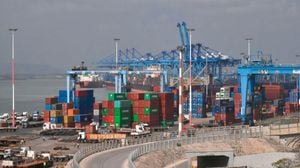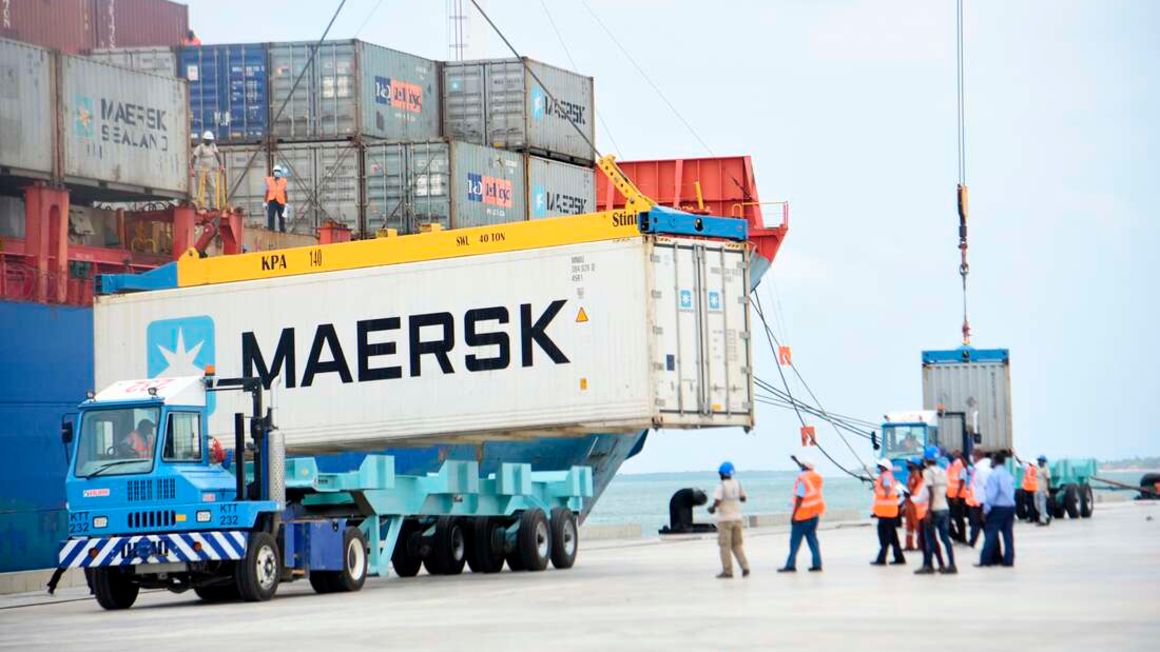Geza Ulole
JF-Expert Member
- Oct 31, 2009
- 59,049
- 79,052

Hehe, Kenya navy needs to purchase a bigger and more modern ship for force projection against any threat that comes from the horn of Africa...Global shipping companies’ plans for Kenyan ports
WEDNESDAY JULY 28 2021

Containers at the Port of Mombasa on March 2, 2021. FILE PHOTO | NMG
By ANTHONY KITIMO
More by this Author
SUMMARY
- A Danish international container shipping company, Maersk Line, and the third largest shipping company, CMA CGM have announced a number of changes to serve Mombasa and Lamu ports.
- Maersk, the world’s largest shipping company on Monday stated that it is enhancing the service it offers from Mombasa to North Europe.
Two world’s largest container shipping companies are redesigning their network to enhance their services to serve two Kenyan commercial ports to offer more flexibility to customers’ supply chains.
A Danish international container shipping company, Maersk Line, and the third largest shipping company, CMA CGM have announced a number of changes to serve Mombasa and Lamu ports.
Maersk, the world’s largest shipping company on Monday stated that it is enhancing the service it offers from Mombasa to North Europe, specifically Felixstowe and Rotterdam, by providing a single transhipment product via Salalah.
Maersk Eastern Africa managing director Carl Lorenz in a statement said the changes in network are primarily aimed at providing higher predictability and offering more flexibility to customers’ supply chains.
Mr Lorenz said redesigning the network from Salalah, the ME7 service will bring more resilience to customers’ supply chains, further protecting them from operational challenges that arise out of contingencies.
“We welcome the redesign of our ocean network from Salalah which will connect our Kenyan customers cargo to Europe through a single transhipment. This ocean product enhancement will ensure further peace of mind to Kenyan exporters injecting more resilience, predictability, and reliability into our customers’ supply chains, particularly essential for perishable cargo from Kenya,” said the director.
“It’s great to see this important market being prioritised where global reliability in Ocean Freight is more of a challenge than ever. “
I sgree. The attack can come from the sea and so we need to modernise our naval fleets. This idea of operating these old naval vessels is totally unacceptable. We also need to be alert and ready to respond to any attack on land. Al Shabab have also attacked a US base in Lamu which is not very far from the port. We should avoid any attack in Lamu because any attack in Lamu even if it is not on Lamu port itself could make investors develop cold feet. I say the government should build a big army base in Lamu and a big permanent naval base in Lamu port. These security installations will convince investors that there is adequate security there.Hehe, Kenya navy needs to purchase a bigger and more modern ship for force projection against any threat that comes from the horn of Africa...
A ship that costs like $400m and other smaller but more modern fast attack vessels that can quickly respond to pirate attacks, illegal fishing by foreign vessels and such...
The seas are becoming too important for Kenya to fail, we need to get this right before some security incident messes everything up for us... You only need one piracy attempt and ships start avoiding Lamu for it's proximity to Somalia waters.
Word is Manda Bay will be dredged and expanded in order to accommodate a larger presence of Kenya Navy boats and ships . This is in anticipation of whatever ruling that Kenya will get at the ICJ.I sgree. The attack can come from the sea and so we need to modernise our naval fleets. This idea of operating these old naval vessels is totally unacceptable. We also need to be alert and ready to respond to any attack on land. Al Shabab have also attacked a US base in Lamu which is not very far from the port. We should avoid any attack in Lamu because any attack in Lamu even if it is not on Lamu port itself could make investors develop cold feet. I say the government should build a big army base in Lamu and a big permanent naval base in Lamu port. These security installations will convince investors that there is adequate security there.
great content by afrikan traveller again

I can see hata terminal III (berth 23) nayo iko like 60 dredged already.Google maps picture of Mombasa port second container terminal II. Good progress has been made.
View attachment 1880531
Yeah you are right. The Japanese through JICA have introduced a culture of continuous development in Mombasa port in the sense that we no longer wait for the berth capacity to be filled before we start a new project. We start construction of a new berth as soon as construction of the current berth is complete. The Japanese through Jica are willing and ready to loan us any amount of money and expertise we need to expand Mombasa port. They have financed second container terminal I, II and III and they also financed older berths. They have been a good partner.I can see hata terminal III (berth 23) nayo iko like 60 dredged already.
Yes, na loan zao hua ni kama 0.8% interest, Kuna Nyengine ya berth 21 ilikua 0.2% interest.. uki compare na China ambao hufika hadi 7.5% interest !!!Yeah you are right. The Japanese through JICA have introduced a culture of continuous development in Mombasa port in the sense that we no longer wait for the berth capacity to be filled before we start a new project. We start construction of a new berth as soon as construction of the current berth is complete. The Japanese through Jica are willing and ready to loan us any amount of money and expertise we need to expand Mombasa port. They have financed second container terminal I, II and III and they also financed older berths. They have been a good partner.